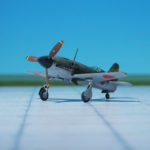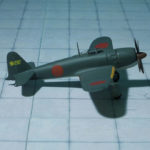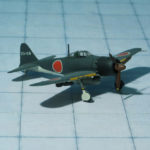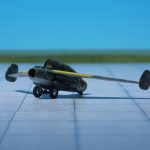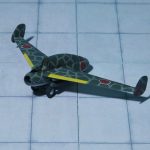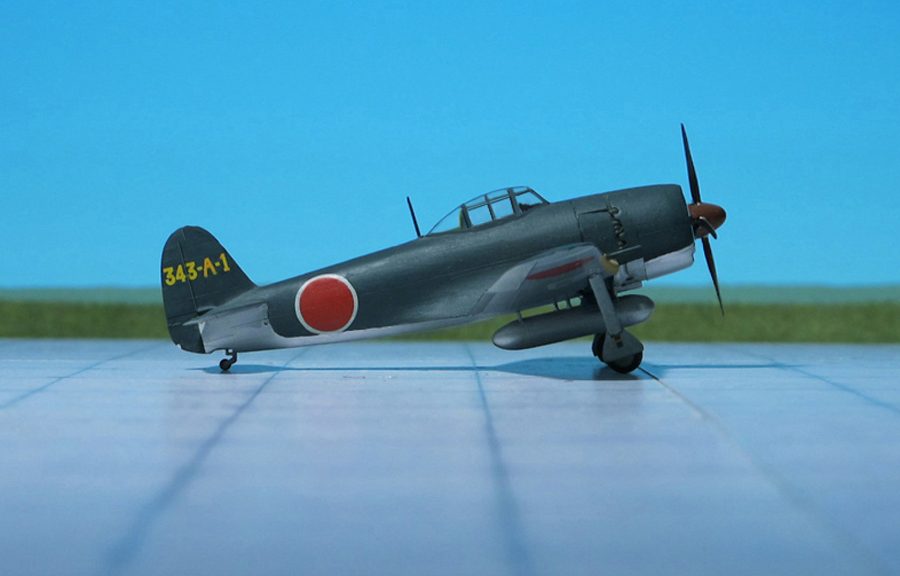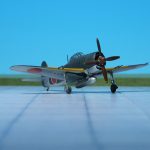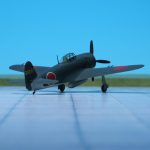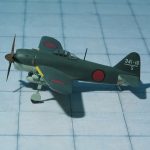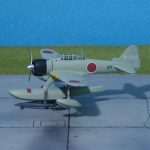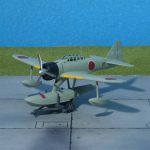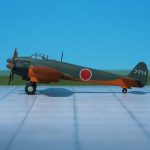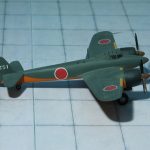TYPE: High speed fighter project
ACCOMMODATION: Pilot only
POWER PLANT: One Daimler-Benz DB 601A liquid-cooled engine, rated at 1,159 hp
PERFORMANCE: No data available
COMMENT: Every aircraft creator seeks to reduce drag in their designs. The more drag, the slower the aircraft moves through the air due to the resistance. Drag cannot be completely removed from a design, but even in the early years of aviation various methods for minimizing drag were investigated and many different solutions were tried.
Not surprisingly, such applications were valued by those providing the military with aircraft and in Japan, prior to the outbreak of hostilities with the US, the Dai-lchi Kaigun Kok[ Gijutsu-sho (Yokosuka Naval Air Technical Arsenal, Kugisho) would study such efforts in an attempt to produce fast flying aircraft.
With the war clouds looming on the horizon, the seeds planted by the air racers of the 1920s and early 1930s were germinating in the aircraft used by the air forces of the major powers. Designs by Curtiss for the US Army Air Force were influenced by the Curtiss racers while the retractable landing gear of the 1920 Dayton Wright RB racer would become a hallmark of Grumman aircraft such as the F2F. In Great Britain, R. J. Mitchell would draw heavily from his experience designing Schneider Trophy racers to build the Supermarine Type 300 which would eventually evolve into the Supermarine Spitfire.
On 26 April 1939 German test pilot Fritz Wendel flew to a new world speed record of almost 469 mph with a Messerschmitt Me 209. The Me 209 was solely designed to break speed records and was a completely separate aircraft from the Messerschmitt Bf 109 that entered service with the German Luftwaffe at that time. It shared only its Daimler-Benz DB 601 liquid-cooled engine with the Bf 109.
Consequentially, Japan sought to produce racing aircraft and planes designed to beat world speed records. In 1938, a group of designers sought to produce a high-speed aircraft to challenge the world air speed record. Once war had broken out this aircraft, called the Ken lll, was soon taken over by the Imperial Japanese Army (IJA). Redesignated the Ki-78, its development was continued under Kawasaki. During this time, it may have been the Imperial Japanese Navy (IJN) who decided to conduct its own studies of high speed aircraft with Kugisho assigned the task of doing so. Whether the studies were initiated in response to the IJA’s own high-speed aircraft project is unknown but the prevalent aircraft design philosophy of both the IJN and the IJA prior to the war was of speed, agility and range at the expense of fire- power, durability and protection.
Kugisho examined over half a dozen aspects of aerodynamics in order to produce data on what would be needed to realize an aircraft capable of significant speed. One leading point of research was the main wings. The shape of a wing is one of the more critical aspects of aircraft design. Factors such as wing loading, expected air speeds, angles of attack and the intended use of the aircraft all influence how the wing is shaped. For high speeds, a low aspect ratio wing is often considered. Typically, these are short span wings with the benefits of higher maneuverability and less drag. In addition, having a backward sweep to the wing also lowers drag. The drag most associated with wings is termed induced drag, which is caused by wing tip vortices that change how the air flows over the wings. This change results in less and less lift which then requires a higher and higher angle of attack to compensate and, from this, induced drag results. Elliptical wings offer less induced drag than more conventional straight wings. However, low aspect ratio wings are more prone to larger vortices because they cannot be spread out across a longer wing.
Kugisho’s study on wing shapes was the likely result of testing various airfoils in a wind tunnel to determine their effectiveness and record the results. Another aspect Kugisho engineers reviewed were the merits and flaws of using either an inline or a radial engine and how each type reduced the form drag. In both cases the engineers drew up two concept aircraft and each made use of streamlining. Streamlining is the process of shaping an object, in this case, a fuselage, to increase its speed by reducing the sources of drag.
One concept used the German 1,159hp Daimler-Benz DB 601A, a 12-cylinder, inverted-V, liquid-cooled, inline engine. This engine would be license built for the IJN as the Aichi AEl Atsuta (the ‘A’ stood for Aichi, ‘E’ for liquid-cooled and ‘l’ for first liquid-cooled engine. Atsuta was a holy shrine in Aichi Prefecture) and for the IJA as the Ha-40, before it was renamed the [Ha-60] 22.
The second concept aircraft (Kugisho High-Speed Aircraft Project with NK-1B) used a 1,000hp Nakajima NKlB Sakae 11 which was a 14-cylinder, air-cooled, radial engine. This engine was a license version of the French Gnome-Rhone l4K Mistral Major (in engine nomenclature, the ‘N’ was for Nakajima, ‘K’ for air-cooled, ‘1’as the first air-cooled engine, while the ‘B’ was for the second version of the NKl; Sakae means prosperity in Japanese).
Kugisho would use the same basic airframe for the engine study. It consisted of a well streamlined fuselage with the pilot mounted in a cockpit set behind the wing and just forward of the vertical stabilizer. This style was found in a number of racing aircraft such as the American GeeBee Rl and Geebee Z. Both aircraft used a standard tail-sitter configuration for the landing gear. The concept equipped with the DB 601A engine had a fuselage shape that was not unlike the Kawasaki Ki-61 Hien (“Swallow”, codenamed “Tony” by the Allies) which would appear in prototype form in December 1941 . The wings were mounted low on the fuselage. The fuselage appearance was due to the inverted-V engine which, by design, offered lower height, weight and length when compared to more conventional engines.
By contrast, the concept using the Nakajima NKlB had a more ovoid fuselage shape, the result of the height of the radial engine. To maintain the aerodynamic streamlining a large spinner was used. Also, in contrast to the DB 601A equipped design, the wings were mounted mid-fuselage.
Kugisho would not produce any direct prototype aircraft from either concept. lnstead, results of the various studies were likely kept available as reference for engineers to access as a means of obtaining data on the aerodynamic problem. Perhaps Kugisho in hindsight considered themselves fortunate to not have expended additional expense and effort in producing working prototypes given the failure of the IJA’s Kawasaki Ki-78, a program that lingered on into 1944 and never met its design goals (Ref.: Dyer III, Edwin M.: Japanese Secret Projects, Experimental Aircraft of the IJA and IJN 1939-1945, Midland Publishing, Hersham, U.K., 2010).



